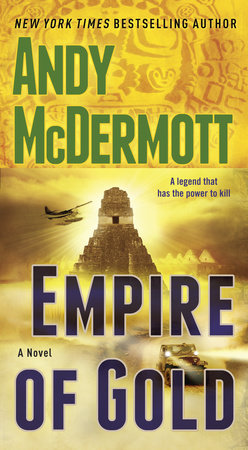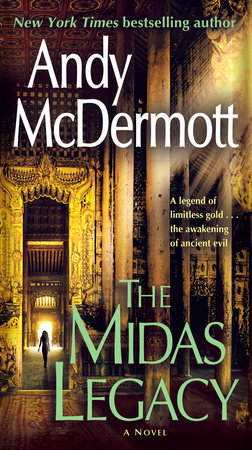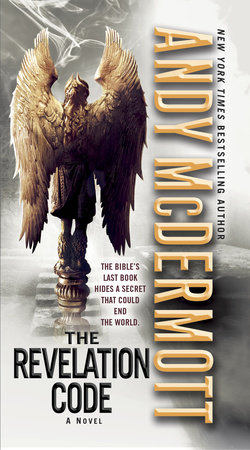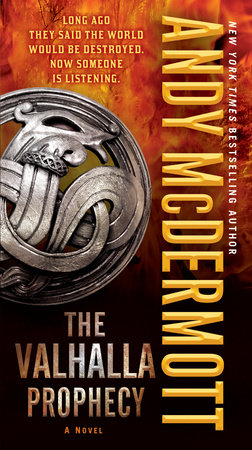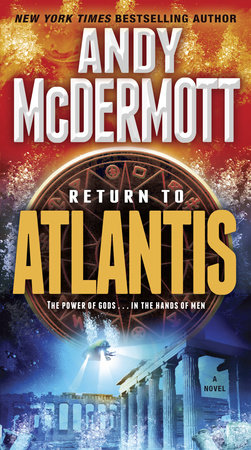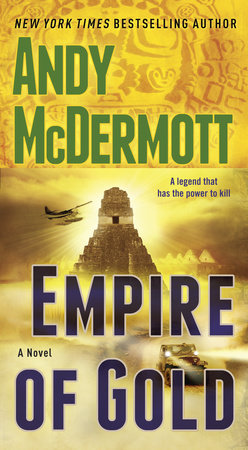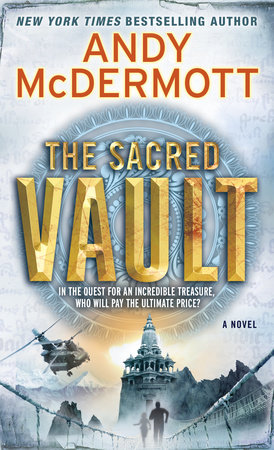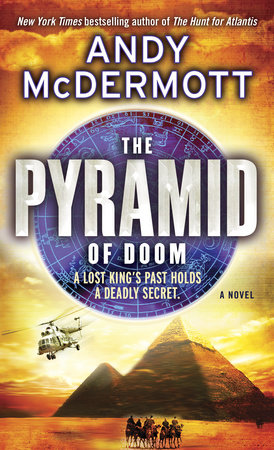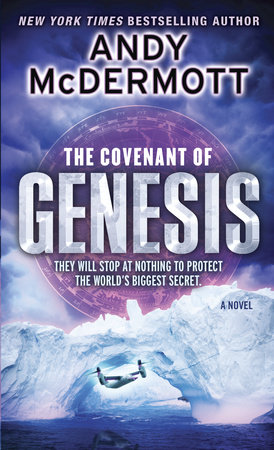Excerpt
Empire of Gold
ONE
New York City
Eleven Years Later
Eddie Chase strolled into the office with his hands behind his back and a knowing smile on his face. “Ay up, love.”
His wife looked up from her laptop with a faint frown. “Where’ve you been?” asked Nina Wilde, flicking a strand of red hair away from her face. “We’re going to be late.”
“We’ve still got ten minutes. Anyway, I’m amazed you noticed I was gone, since you haven’t lifted your nose out of that lot all morning.” He glanced at the stacked paperwork on her desk.
“Don’t be a smart-ass.” She eyed him more closely, noticing his expectant smirk. “What have you got behind your back?”
He stepped forward. “Oh, nothing. Just . . .” With a flourish, he dropped a large brown paper bag beside her computer. “Lunch.”
Nina did a double-take as she recognized the logo on the bag. “Aldo’s Deli?” Her frown was replaced by surprised delight. “Wait, you went all the way to Aldo’s just to get me a sandwich?”
Eddie shrugged, looking out at the view of Manhattan beyond the windows of the United Nations Building. “It’s only in the East Village. It’s not that far.”
She opened the bag, and her look brightened still further. “You didn’t.”
“I did. Your favorite. Extra-peppered pastrami on rye, with lettuce, tomatoes, pickled onions, not regular ones . . . and Aldo’s special chili sauce. Just like you used to get when we lived down there.”
Nina almost reverently unwrapped the sandwich. “That was over four years ago. I can’t believe you did this.” She was about to take a bite when she paused. “Why did you do this?”
“What, a bloke can’t do something nice for his wife once in awhile?”
“Not when she knows him as well as I know you.” A sly smile. “This wouldn’t be a peace offering, would it?”
“Pfft, don’t be daft. What’ve I got to apologize for? I’m right.”
Her green eyes narrowed, the smile fading. “Don’t even start.” A discussion the previous night about the week’s main news story had somehow degenerated into a full-blown argument, and the atmosphere had still been frosty even over breakfast. A New Yorker named Jerry Rosenthal was on trial for having killed the man accused of raping his daughter after the case against him collapsed. To Nina it had been an open-and-shut case of revenge-driven vigilantism, but Eddie had very different opinions.
Which he still held. “What, so you’re saying that if it had been your daughter, you’d be happy to let the guy walk the streets because of some forensics cock-up? We know he did it, he just got away with it on a technicality.”
“We don’t know he did it,” she said irritably. “You weren’t there—you didn’t see what happened.”
“Neither did you.”
“Which is why we have courts to decide whether a person’s guilty or not. And why we have courts to decide on the sentence—rather than some guy appointing himself judge, jury, and executioner. That’s not justice.”
“Sounds like it to me. You know somebody’s done something bad and thinks they’ve got away with it? Boom. Kill the fucker.”
Nina huffed. “Eddie, I really don’t want to get into this again. You know what? I’m just going to eat my sandwich—for which thank you very much, by the way. And,” she added, “you are not going to get the last word just because my mouth’s full!”
“As if I would,” said Eddie, who had been planning to do exactly that.
She was about to take a bite when there was a knock at the door. Before she could ask who it was, Macy Sharif entered. “Hey, Nina. Hi, Eddie.” The archaeology student, who had helped them discover the Pyramid of Osiris beneath the Egyptian desert the previous year, had accepted Nina’s invitation to spend part of her summer vacation as an intern at the International Heritage Agency before completing her final year of study. “Dr. Bellfriar sent me to get you.”
“Bet I know what he’s going to say,” said Eddie
with a mocking grin. “Eight months of looking at the things, and he’ll tell us . . . they’re made of stone. Thank you, that’ll be fifty grand plus expenses.”
“Oh, he’s got way more to say than that,” said Macy, the Englishman’s sarcasm fluttering past her unnoticed. “I should know. I had to make all his PowerPoint slides.”
“Not enjoying your current assignment?” Nina asked in an impish tone.
“No, no, it’s fine!” said Macy hurriedly. “Just that I was hoping to do something a bit more fieldworky. With you.”
Nina patted one of the stacks of documents. “Funny, I was hoping to do some fieldwork too! But then some idiot tried to kill a bunch of world leaders, and we made a find that changes the face of archaeology, and, well, high-up people want to know about it. In triplicate.”
“Maybe Bellfriar’s found something that’ll give you an excuse,” Eddie suggested.
Nina looked hopefully at Macy, who tried unsuccessfully to hide a doubtful expression. “Anyway,” said the young woman, “you can see for yourself. He’s with Mr. Penrose and the others in the conference room.”
Nina took a quick bite from her sandwich before getting up from her desk. “What?” she asked Eddie as she chewed. “I haven’t had lunch yet; I’m hungry. Come on.”
“Do I have to?”
“If I do, so do you.” She shooed him from the office.
Macy led the way to the conference room. As well as Dr. Donald Bellfriar, also present were several United Nations officials headed by Sebastian Penrose, who acted as liaison between the UN proper and its semi-independent cultural protection agency. “Ah, hello, Nina,” said the bespectacled, officious Englishman.
“Sebastian,” Nina replied. “I didn’t expect so many people.”
“Everyone loves a mystery,” Penrose said. “I think they’re hoping Dr. Bellfriar has the solution.”
Nina shared a knowing look with Macy. “We’ll find out soon enough.”
Everyone took their seats, Macy working a laptop and projector as the Oregonian geologist carefully smoothed his sweeping silver hair before addressing his audience. “Good afternoon, everyone. Before I start, I’d like to say how great it’s been to work with the IHA on this. I suppose that when archaeology can’t provide the answers, it’s time to call on the rock stars!” He chuckled immodestly at his pun, which was received with appropriately stony silence. “Rock stars? No? Anyway, thank you, Dr. Wilde—and thank you, Miss Sharif, for all your assistance. And for being enjoyable company.” Macy beamed.
“He was probably enjoying the view more than the conversation,” Eddie whispered to Nina.
“Shush,” she whispered back, although he had a point. While Macy had spent her internship modestly dressed by her standards, in the formal surroundings of the UN the beautiful Miamian’s predilection for tight designer clothing made her stand out like a bikini model in a Saudi mosque.
Bellfriar began his presentation proper, opening a case to reveal his subjects: a pair of small statues, crude human figures carved from an odd purple stone. The first had been found by Nina, Eddie, and Macy inside the Pyramid of Osiris; the second, stored with stolen cultural treasures in a former Cold War bunker beneath the glacial ice of Greenland. He summarized the circumstances of each discovery before continuing: “Now, despite their best efforts, Interpol have so far been unable to find
out where the second statue was stolen from, and since
neither relic appears to be the product of any known
ancient culture, that would seem to be a dead end in
the search for answers. Fortunately, other branches of science can provide a different perspective. Miss Sharif?”
Macy tapped at the laptop, projecting the first slide onto the conference room’s screen. It showed the two statues placed side by side. “As you can see,” said Bellfriar, “the statues are clearly part of a set, and meant to fit together. Note how the arms are positioned so they’ll interlock. But as you see here”—he nodded, and Macy clicked to the next slide—“it’s obvious that the set is incomplete.”
The new image showed the statues from directly above. They had been positioned in such a way that, facing outward with one shoulder touching, they formed two sides of a triangle—and, as Bellfriar had said, it was evident that a third figurine would perfectly complete the group. “Using simulation software,” said the geologist proudly, “I can show you what the missing one would look like.” Another slide, and the two statues were shown flanking a computer-generated image of a third. All three were broadly similar, the only appreciable difference being the position of the arms. “And here’s how they fit together . . .”
The photos of the figures were replaced by CG copies that began a showy animated display, spinning around one another before slotting into a shoulder-to-shoulder triptych. The UN observers seemed impressed, but Nina was less so, having seen the IHA’s own computer simulation of the missing figure over seven months earlier. “That was one of the first things we realized when we received the second statue,” she said. “There was—and hopefully still is—a third. The question is, where?”
“Well, before we can ask where,” said Bellfriar amiably, “we first have to ask what. As in, what are the statues made of?” He indicated the two figures in the case. “As you see, they have an unusual color, this strong purple, with a rather vitreous luster. Some form of bornite was my first thought, but the copper content in the scrape sample I took was far too low—almost nonexistent, in fact. But the density of the rock was surprisingly high, so it had an appreciable metal content . . .”
Nina glanced at Eddie as Bellfriar launched into a detailed account of his mineralogical tests. His eyes had glazed over. She tapped his foot with hers. “Sorry,” he muttered. “Geology’s even more boring than archaeology.”
She was about to jab his foot again, this time with her high heel rather than her toe, when Bellfriar’s words caught her full attention. “. . . which brought me to my conclusion: The rock from which the statues were carved was probably mesosideritic.”
It took a moment, but the term produced a match from Nina’s mental database. “A meteorite?”
Bellfriar was impressed. “You know about meteorites, Dr. Wilde?”
“From an archaeological standpoint. There was a dagger made from meteoric iron in Tutankhamen’s tomb, and some Inuit and Native American tribes also made ceremonial weapons from it. And there was an East African tribe that worshipped a fallen meteorite. But apart from that, only really what I remember from Astronomy 101.”
“Well, I can give you a brief refresher course,” said Bellfriar, chuckling again. “A mesosiderite is a stony-iron meteorite, which as the name suggests is made up of a combination of rock and metal. They’re very rare—there are fewer than a hundred and fifty known examples, I believe.”
“You said it’s probably a . . . a mesosiderite,” said Penrose, almost stumbling over the word. “Can’t you be sure?”
“Not without cutting one of the statues in two to make a microscope slide, and I doubt Dr. Wilde—or the Egyptian government—would be happy about that! But the tests I could do seemed reasonably conclusive. Although,” he added, “if there’s any way at all I could get a larger sample, I’d very much like to carry out further tests. The rock has some unusual properties.”
“In what way?” asked Nina.
“The density, for one thing—either the iron content is much higher than I’d expect, or there are heavier metals in there as well. There are also traces of organic compounds.”
Eddie gave the statues a deeply suspicious look. “Wait, there was something alive inside the meteor? Like the Blob?”
Bellfriar laughed. “No, no. If a compound is ‘organic,’ then chemically it just means it contains carbon. Meteorites might have carried the precursors of life to earth, though; there was a famous find in Australia, the Murchison meteorite, which contained amino acids. I don’t know if that was the case here—but I did notice something else.” He turned to Macy. “Miss Sharif, can you skip forward to . . . I think slide seventeen?”
Macy tapped the keyboard. Slides flashed on the screen, stopping at an image of one statue’s surface taken through a microscope. At extreme magnification, the stone was a fractal microcosm of a rocky landscape, with what seemed almost like man-made features running through it: a fine grid-like pattern.
“Looks like a developer’s laying the ground for a new subdivision,” said Nina.
“It does, doesn’t it?” replied Bellfriar. “I wouldn’t want to live there, though—not a lot of space. The lines are only about fifty micrometers apart, less than the width of a human hair.”
“What is it?” Eddie asked.
“Some kind of carbon matrix infused into the meteoric iron. Naturally formed, of course—it looks artificial, but on this scale so do a lot of processes. What’s interesting is that it’s greatly increased the hardness of the rock, as if the whole thing has been reinforced with carbon nanotubes. Normally, this kind of stone would be around a five or six on the Mohs scale—diamond tops the scale at ten, by the way,” he added for the benefit of the nonscientists. “The statues are actually harder than the porcelain streak plate I initially tried to use to test them, so on the Mohs scale they’re at least a seven—stronger than quartz.”
His description had sparked another of Nina’s memories—this time from personal experience. “The rock,” she began, her cautious, probing tone immediately catching Eddie’s attention, “does it have any other unusual properties? Like, say . . . high electrical conductivity?”
“Actually, yes,” said Bellfriar, surprised. “It’s due to the iron content, of course, but it was higher than I expected. How did you know?”
“It just reminded me of something I’d seen before,” she said casually. “But it’s not important. What else have you found out?”
Bellfriar returned to his presentation, but Nina was no longer listening, instead running through theories of her own. When he finished, twenty minutes later, she thanked him for his work, then waited for the United Nations officials to conclude their pleasantries, trying not to seem too eager for everyone to leave.
“What is it?” whispered Eddie.
“I’ll tell you in private,” she murmured before calling across the room, “Macy?”
Macy was shutting down the laptop. “Yeah?”
“Can you take the statues to my office, please?”
“Taking them back off me so quickly, Dr. Wilde?” said Bellfriar in jovial mock offense. “I hope you’re not disappointed that I didn’t pinpoint where they came from?”
“No, not at all,” Nina told him as the puzzled Macy closed the case containing the statues. “You’ve given me a lot to think about. Oh, Sebastian,” she added as Penrose was about to leave, “can I have a quick word with you? We need to finalize the details of, uh . . . the Atlantis excavations.”
Penrose covered his momentary confusion—the IHA’s undersea archaeological work at the ruins of Atlantis was already under way—and nodded as he left. Macy, carrying the case, went out after him. Nina and Eddie followed, and the four met again in Nina’s office.
“Okay,” said Eddie, “what the hell was all that about?”
“A good question,” said Penrose. “I take it you’ve realized something, Nina.”
“I think so,” she replied, shoving papers—and the sandwich—aside to clear a space on her desk. “Macy, put the case down here.”
Macy obeyed. Nina opened the case and regarded the two crude statues. “When Bellfriar mentioned carbon nanotubes, it made me think of something I’ve seen before. Excalibur.”
“Excalibur?” exclaimed Macy. “What, the Excalibur? As in King Arthur?”
“That’s the one,” said Eddie.
“Wow! I knew you found King Arthur’s tomb, but I didn’t know you found Excalibur as well.”
“We did, but we . . . lost it,” said Nina. That wasn’t quite true, as she knew exactly where it was: She and Eddie had hidden it again to keep it out of the wrong hands. “But it had some very special properties . . . and they sounded a lot like what Bellfriar just described. Eddie, can you close the blinds? I need the room as dark as possible.”
Eddie began to lower the blinds. “We’ve been married for a year and a half—we don’t have to do it with the lights off anymore.”
“Ha ha,” said Nina, not amused. “Ignore him, he’s joking,” she added to Macy, sensing that the younger, far less inhibited woman was about to ask a very personal question. “But one of Excalibur’s properties was that it was made from a superconductive metal—and it could conduct more than just electricity.”
The blinds were now closed, the office in a gloomy twilight. Nina reached for a statue. “Okay, let’s see if I’m right . . .”
She picked it up—and the stone glowed faintly, the light quickly fading to nothing.
Penrose’s eyes widened, and Macy gasped. “What was that?” she said.
“That was earth energy,” said Nina. “It’s a network of lines of natural power that flow around the planet, and converge in certain places. If you’re in one of those places and the earth energy is strong enough, you can tap into it and use it—if you have a superconducting material to make the connection.”
“Should Miss Sharif be seeing this?” asked Penrose, a stern tinge to his voice making it clear that he thought she definitely shouldn’t.
“I’ll vouch for her,” said Nina, giving Macy a quick, reassuring smile. “Besides, she discovered this statue, and I gave her the job of finding out more about it—I think this counts. And it beats making PowerPoint slides.”
Nina returned the first statue to the case and picked up the other. Again, a shimmering glow ran briefly over the figure’s surface before disappearing. Nina was about to put the statue back down, then changed her mind
and picked up the first once more. This time, nothing happened—until she put the two figurines together,
linking them shoulder-to-shoulder in the same way as Bellfriar’s slide. Both statues glowed, the light slightly stronger than before. The effect lasted for a few seconds before dwindling.
Macy hesitantly touched the figures, but nothing happened. “Why did they do that? And how come it never happened before? Dr. Bellfriar had them for months, and he never saw anything like this.”
“It never happened before because only certain people can cause the effect,” said Nina. “People like . . . me. I don’t know how or why—the best theory is that
it’s genetic—but there’s something about my body’s bioelectric field that lets me channel earth energy through a superconductor.” She opted, for now, not to explain to her friend that her genetic heritage went all the way back to the lost civilization of Atlantis, destroyed eleven thousand years before—and that the actions of other Atlantean descendants had almost brought about a global genocide. “We discovered it when we found Excalibur.”


